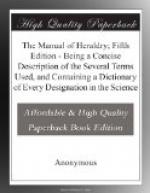The Archbishop of York has precedence of dukes and great officers of state, except the lord chancellor. He is called His Grace and Most Reverend Father in God; and styled Primate of England and Metropolitan.
ARGENT. The French word for silver, of which metal all white fields or charges are supposed to consist.
[Illustration: Argent]
ARMED. This word is used to express the horns, hoofs, beak, or talons of any beast or bird of prey, when borne of a different tincture from those of their bodies.
[Illustration: Armed]
Ex. Crest, a demi-griffin armed, gules.
ARMORIST. A person skilled in the bearings of coats of arms, and all relating to their emblazonment.
ARMS. A word derived from the Latin arma, which signifies in Heraldry a mark of honour, serving to distinguish states, cities, families, &c.
ARROWS. Short darts feathered at the ends.
[Illustration: Arrows]
Ex. Argent, three arrows paleways, points in chief sable, feathered.
ASPECTANT. Animals placed face to face in a charge are said to be aspectant. If they are about to attack each other, they are said to be combatant.
ASSUMPTIVE. Arms assumed without being sanctioned
by a grant from the
College of Heralds.
ASSURGENT. A man or beast rising out of the sea is said to be assurgent.
ATCHIEVEMENT. The coat of arms fully emblazoned according to the rules of Heraldry. The lozenge-shaped atchievements that are displayed on the outside of the houses of persons deceased are commonly called Hatchments.
ATTIRED. When the horns of a stag are of a different tincture to its head, it is said to be attired.
[Illustration: Attired]
Ex. Argent, a stag lodged, proper, attired, or
AUGMENTATION. This word signifies in Heraldry a particular mark of honour, granted by the sovereign in consideration of some noble action, or by favour; and either quartered with the family arms, or on an escutcheon or canton.
[Illustration: Augmentation]
Ex. Ermine, on a chevron azure, three foxes’ heads erased, argent. The augmentation is in a canton azure, a fleur-de-lis argent.
AZURE. The French word for blue: it is distinguished in heraldic engraving by lines running parallel to each other in an horizontal direction, as in the annexed example.
[Illustration: Azure]
BADGE. A distinctive mark worn by servants, retainers, and followers of royalty or nobility, who, being beneath the rank of gentlemen, have no right to armorial bearings. The rose and crown is the badge of the servants, &c., of the Kings of England: they are displayed as in the annexed example.
[Illustration: Badge (Rose and Crown)]
BANDED. Anything tied with a band.
[Illustration: Banded]




